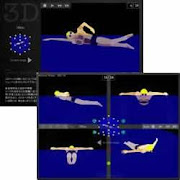 Courtesy of WOWSA, Huntington Beach, California.
Courtesy of WOWSA, Huntington Beach, California. John Kinsella in the 1970’s, Paul Asmuth in the 1980’s, Shelley Taylor-Smith in the 1990’s and Petar Stoychev most recently dominated the professional marathon swimming circuits in their era.
Each of these athletes was crowned champion based on a point system. The swimmers were awarded points based on their finish at each race. During the 1960’s, 1970’s and 1980’s, the athletes swam under a point system sanctioned by the World Professional Marathon Swimming Federation.
 The point system used was the brainchild of Edward Nichterlein, a former statistician of the National Football League. Edward worked out a rather complicated method of scoring finishers that analyzed various elements of marathon swim racing.
The point system used was the brainchild of Edward Nichterlein, a former statistician of the National Football League. Edward worked out a rather complicated method of scoring finishers that analyzed various elements of marathon swim racing.Several categories of scoring were established. First, finishing positions were rewarded on the basis of 500 points for the winner, 350 for his runner-up, 250 for the third-placer, 150 for fourth position, 125 for fifth, 100 for sixth, 95 for seventh, and five points less for each succeeding slot down to 25th place.
Comparative times were also taken into consideration, and the race winner’s time was rated at 100 (later 300) points, with one point subtracted from the scores of those following him to the finish line for each minute longer they took to arrive there.
 Then, since races were held over varying distances, each finisher was awarded five points per mile for the length of the course. For example, finishers in a 20-mile race received 100 points, while those who completed a 10-mile race received 50 points, in addition to their scores for placement and finish times.
Then, since races were held over varying distances, each finisher was awarded five points per mile for the length of the course. For example, finishers in a 20-mile race received 100 points, while those who completed a 10-mile race received 50 points, in addition to their scores for placement and finish times.A bonus of 100 points was also awarded to swimmers who lowered the established course record.
 Men and women were scored separately, but on the same basis. The first woman to finish, even if she was sixth overall, was considered the woman’s winner and received 500 points for “first place’” 100 points for her time and, of course, the distance points. This meant that a man following her to the finish line, although seventh in the overall race standings, was considered sixth in the men’s point standings toward the championship.
Men and women were scored separately, but on the same basis. The first woman to finish, even if she was sixth overall, was considered the woman’s winner and received 500 points for “first place’” 100 points for her time and, of course, the distance points. This meant that a man following her to the finish line, although seventh in the overall race standings, was considered sixth in the men’s point standings toward the championship.Currently, FINA uses two much simpler point systems: one for the FINA Open Water Swimming Grand Prix (for races longer than 10K) and one for the FINA 10KM Marathon Swimming World Cup.
In each FINA Open Water Swimming Grand Prix race, points are awarded depending upon overall finishing position. The Grand Prix points are different based on the total prize money offered by the race director.
For FINA Open Water Swimming Grand Prix races that offer total cash prizes more than US$25,000, the points are as follows:
1st is 25 points
2nd is 19 points
3rd is 16 points
4th is 13 points
5th is 11 points
6th is 9 points
7th is 7 points
8th is 5 points
All other finishers of the race receive 4 points.
For FINA Open Water Swimming Grand Prix races that offer total cash prizes between US$10,000 and US$24,999, the points are as follows:
1st is 20 points
2nd is 16 points
3rd is 14 points
4th is 12 points
5th is 10 points
6th is 8 points
7th is 6 points
8th is 5 points
All other finishers of the race receive 3 points.
For FINA Open Water Swimming Grand Prix races that offer total cash prizes between US$10,000 and US$19,999, the points are as follows:
1st is 15 points
2nd is 11 points
3rd is 9 points
4th is 7 points
5th is 6 points
6th is 5 points
7th is 4 points
8th is 3 points
All other finishers of the race receive 2 points.
For the FINA 10KM Marathon Swimming World Cup races, the points are as follows:
1st is 20 points
2nd is 18 points
3rd is 16 points
4th is 14 points
5th is 12 points
6th is 10 points
7th is 8 points
8th is 6 points
9th is 4 points
10th is 3 points
All other finishers of the race receive 2 points.
Copyright © 2009 by World Open Water Swimming Association




















No comments:
Post a Comment